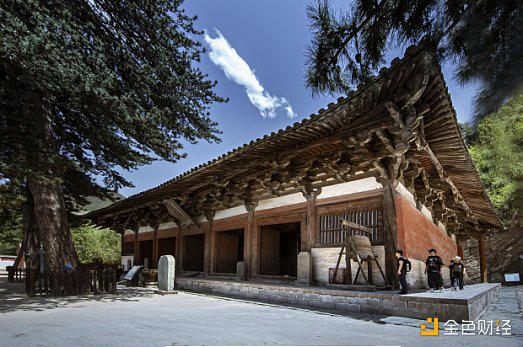On May 19, 2022, the main event of "China Tourism Day" opened in Shanxi. Under the guidance of the Market Management Department of the Ministry of Culture and Tourism, the Shanxi Provincial Bureau of Cultural Relics and the Shanxi Provincial Department of Culture and Tourism jointly launched the "Ancient Architecture with Paintings" public welfare digital cultural and creative collection plan for the public Five types of digital collections of Shanxi ancient architecture with a total of 50,000 copies are released for free. Users can not only experience the beauty of Shanxi's ancient buildings online, but also permanently collect the digital collections of ancient buildings in the cloud based on blockchain technology.
This project takes the national treasure-level immovable cultural relics Foguang Temple, Feihong Pagoda, Yongle Palace, Jinci Temple and Pingyao Ancient City in Shanxi Province as representatives, and creates a series of digital collections of ancient architectural culture in the form of artistic re-creation. Among them, the digital collection of Foguang Temple comes from the architectural manuscripts of Mr. Liang Sicheng. In the early 1930s, Mr. Liang Sicheng and Lin Huiyin led a team to find Foguang Temple in Mount Wutai, Shanxi and recorded it in hand-painted form. Through the combination of ancient buildings and digital technology, more young people are attracted to understand the Chinese cultural stories behind the ancient buildings. At the same time, the project has received strong support from the Shanxi Provincial Youth Development Foundation Sanjin Civilization Watch Special Fund, Shanxi Evening News Wenbo Shanxi, CYTS, and Shanxi University.
In October 2021, the high-intensity rainfall made the ancient buildings within the influence of the heavy rain in Shanxi face a severe test, which aroused the attention of the whole society to the ancient buildings in Shanxi. The public welfare digital cultural and creative collection plan of "Ancient Architecture with Paintings" also hopes to digitally transmit the ancient buildings of Shanxi in the cloud forever, so that the cultural figures of the millennium can be passed on to the next millennium.
The ancient buildings in Shanxi displayed this time and the corresponding digital collections are as follows:
1. Foguang Temple: It was built in the period of Emperor Xiaowen of the Northern Wei Dynasty. It is a rare specimen among the existing ancient wooden buildings in China and even the whole of Asia. It was praised by Mr. Liang Sicheng as "the largest wooden building in China"; The buildings of the Tang Dynasty, the painted sculptures of the Tang Dynasty, the murals of the Tang Dynasty, and the inscriptions of the Tang Dynasty are the "four wonders" of Foguang Temple.
Mr. Liang Sicheng discovered the main hall of Foguang Temple in Mount Wutai on June 26, 1937, and recorded it by hand. The internal and external structure of Foguang Temple is restored through precise drawing stroke by stroke, which is a big step forward for the study of ancient Chinese architecture.

Mount Wutai Foguang Temple

Foguang Temple digital collection "Foguang Temple"
2. Jin Temple: It is the longest and most representative example of the combination of ancient ancestral halls and gardening art, and it is also an intensive carrier of ancient Chinese architectural art; It was posthumously named the King of Jin) and his mother Yi Jianghou and built it. Among them, Nanlaoquan, Maid Statue and Zhou Bai are known as the "Three Wonders of Jin Temple".
The author, Li Ming, adopts the collision method of traditional Chinese painting and modern illustration, and uses the three wonders of Jinci Temple as creative elements to make the painted wooden dragon "live" and support the rich cultural heritage of China's long history with the surging spring water.

Jinci Temple of Our Lady

Jinci Digital Collection "Dream Back to Jinci"
3. Pingyao Ancient City: It was built in the period of King Xuan of Zhou and has a history of 2,800 years. It is an outstanding example of Chinese Han nationality cities in the Ming and Qing Dynasties. It is a precious world cultural heritage and the only ancient city in China. It is one of the two ancient cities that successfully applied for the world cultural heritage.
The author Lin Yan programmed every building with historical memory in the ancient city through digital pixels with a young and novel pixel style, such as the "Rishengchang" bank, which was the prototype of China's first modern bank, and the First Escort in North China, etc., showing Pingyao Ancient City is a historical imprint of the fusion of ancient and modern.

A corner of Pingyao Ancient City

Pingyao Ancient City Digital Collection "HELLO PINGYAO"
4. Feihong Pagoda: In the previous life, it was built in the Han Dynasty as the Buddhist relic pagoda. The current pagoda was built in the sixth year of Jiajing in the Ming Dynasty. It is the highest colorful glazed pagoda in the world. Whenever the sky is clear and the sun shines on the pagoda, various colors complement each other like rain. Hou Changhong, like dancing in the sky, is a representative work among Chinese glazed pagodas.
The author Tim Cheng combines the modern illustration method with the elegant expression technique of ancient murals to reinterpret the rich images of architectural components.

Feihong Tower

The digital collection of Feihong Tower "Shen Shou"
5. Yongle Palace: It was built in the 13th century by the imperial decree of Wokuotai. The construction period totaled 121 years. The entire murals totaled 1005.68 square meters. treasure".
The young author Yihuashe takes the murals on the Sanqing Hall of Yongle Palace as the main inspiration, and uses modern illustrations and color techniques to "reproduce" the murals of Yongle Palace in a younger way, showing the beauty of the murals of the Yuan Dynasty.

Murals of Sanqing Hall in Yongle Palace

Yongle Palace digital collection "Yongle"
 JinseFinance
JinseFinance










